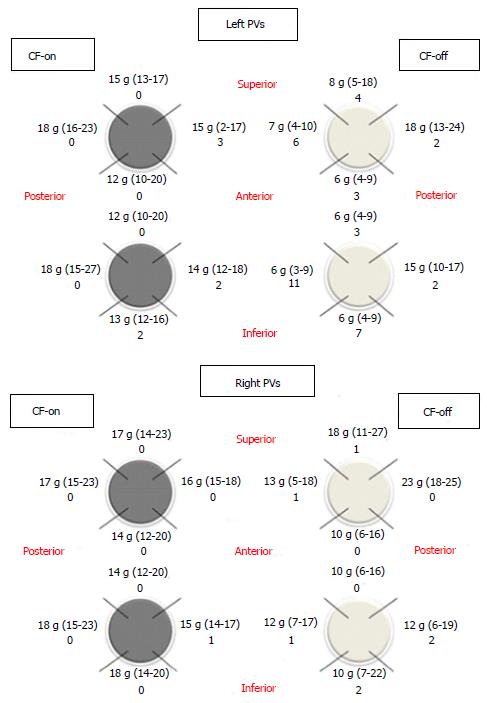Copyright
©The Author(s) 2017.
World J Cardiol. Mar 26, 2017; 9(3): 230-240
Published online Mar 26, 2017. doi: 10.4330/wjc.v9.i3.230
Published online Mar 26, 2017. doi: 10.4330/wjc.v9.i3.230
Figure 1 Contact force variability according to left atrium anatomy.
Contact force (CF) is expressed in grams (g; median and 25th-75th percentile) and the number of pulmonary veins segments with conduction gaps (bold) in the CF-on group (dark gray) and the CF-off group (light gray). Reproduced with permission from Pedrote et al[24].
Figure 2 Automatic tagging of radiofrequency lesions.
The contact force (CF) of each application is color-coded (color bar). The manually acquired RF applications are displayed in green. The central box shows the information collected by the VisiTagTM module on each point, including average CF, time, force-time integral, temperature, power, and delta impedance. The force and impedance graphs from this RF point are shown on the right, and the real-time CF and direction dashboard are shown on the left. Reproduced with permission from Pedrote et al[24]. RF: Radiofrequency.
Figure 3 Stepwise approach for permanent pulmonary vein isolation.
CF: Contact force; PVI: Pulmonary vein isolation.
- Citation: Pedrote A, Acosta J, Jáuregui-Garrido B, Frutos-López M, Arana-Rueda E. Paroxysmal atrial fibrillation ablation: Achieving permanent pulmonary vein isolation by point-by-point radiofrequency lesions. World J Cardiol 2017; 9(3): 230-240
- URL: https://www.wjgnet.com/1949-8462/full/v9/i3/230.htm
- DOI: https://dx.doi.org/10.4330/wjc.v9.i3.230











